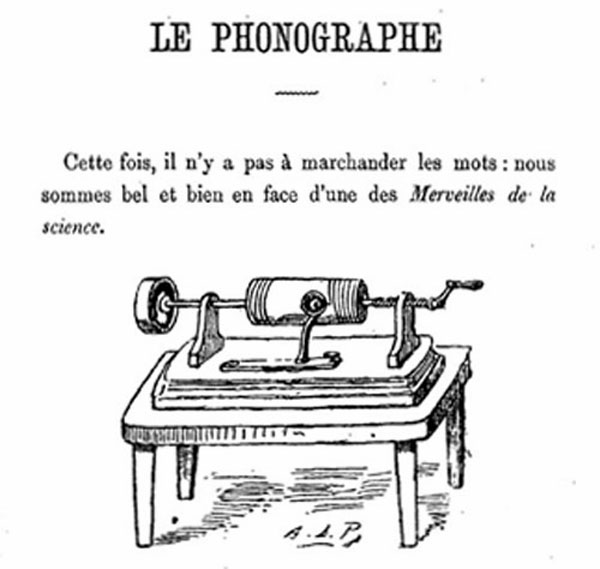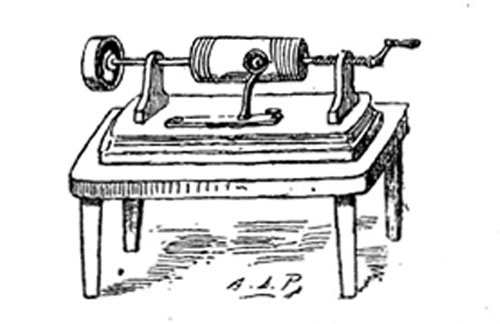The Phonograph
Le Trocadéroscope by Touchatout: Revue tintamarresque de l'Exposition universelle, Paris, 1878
Illustrated by Alfred Le Petit (Courtesy BIBLIOTHÈQUE NATIONALE DE FRANCE)
By Doug Boilesen, 2022 (with translation by Google Lens)
The Phonograph
Le Trocadéroscope by Touchatout: Revue tintamarresque de l'Exposition universelle, Paris, 1878
Illustrated by Alfred Le Petit (Courtesy BIBLIOTHÈQUE NATIONALE DE FRANCE)
By Doug Boilesen, 2022 (with translation by Google Lens)
The 1878 Le Trocaderoscope included a short story titled The Phonograph in their 1878 Exposition edition since Edison's Phonograph was being displayed as one of the new wonders of science at the 1878 Exposition Universelle (a.k.a. the third Paris World's Fair which was held from 1 May to 10 November 1878).
The humorous story provides an alternative history of the phonograph while also raising questions about the consequences of such a marvelous discovery:
"We rejoice at the thought that they will be immense; but one also trembles at the glimpse of what nature they may be."This story is now part of Phonographia's Phonoliterature Library and is another example of connections between the phonograph and the sewing machine.
As will be seen, this story is also a case study of spoken words, no longer ephemeral because of the phonograph, being henceforth available to unequivocally resolve "he said, she said" disputes.

The Phonograph
This time, there is no need to haggle over words: we are indeed in front of one of the wonders of science.

The phonograph, invented by Mr. Edison, American, is absolutely the daguerreotype of sound.
On a small vibrating plate, we talk, we sing, we sniff, we sneeze, we whistle, we...cough.
And immediately, a needle transmits on a strip of lead the imprints of these different noises; they are then shot, and the phonograph then repeats them to you where you want, when you want, as many times as you want.
We think our readers will enjoy learning the circumstances which led to the discovery of this curious instrument.
Here it is:
A few months ago, in New York, a young worker was courted by one of her neighbors, a very pretty boy, by the way, but a little ... Mona Lisa.
One evening, while the young girl was stitching, with the aid of her sewing machine, one of those silver metal thread edgings with which it was the fashion to tuck in camisoles, the young man stood very close to her and spoke to her of his love in exceedingly lively terms.
The needle jumped, fast and light, on the pretty metal braided thread, the young girl blushed and the gallant was pressing.
Suddenly, on a doubt that Marguerite had just raised with regard to the purity of Faust's intentions, the latter exclaimed with the accent of a very sincere conviction:
-- I swear to you, Miss Brigton, that I will marry you!...
The sewing machine stopped short and...
Let's draw a veil over details that don't concern us and step over. . . . . . . . . . . . . . . . . . . . . . . . . . . . . . . . . . . . . . . . . . . . . . . . . . . . . . . . . . . . . . . . . . . . . . . . . . . . . .
Eight months later, Miss Brigton summoned her seducer before a tribunal, according to the custom of the country, and demanded that he either marry her, as he had promised, or pay her thrity-two thousand dollars in damages.
But it was in vain that the beautiful young girl swore to her great gods that the infidel had promised her marriage: she could provide no proof of it.
And when the judge said to the young man:
-- Come, my friend, recall your memories...Have you undertaken to lead Mademoiselle to the altar?
Don Juan would invariably reply in a sardonic tone:
-- No Way!
One of these naughty answers sent the young American into such a rage that she had a nervous attack and fainted, clenching her pretty fingernails, which raked the entire length of the braid of the camisole she was wearing.
With a nervous moment of which she was unaware, the young girl ran her fingers over this embroidery which her charming fingernails plowed from top to bottom.
But what was the astonishment of the judges and the audience on hearing a voice issue from Miss Bridget's garment which articulated very clearly, with the timbre and intonations of the seducer, these terrible words:
-- I swear to you, Miss Brigton, that I will marry you!
These words were even immediately followed by the sounds of a few very sonorous double kisses.
Everyone looked at each other in amazement.
The young man turned very pale.
But, quickly regaining his composure, he said with a smile:
-- It's probably a ventriloquist friend of mine who's in the room playing a joke on me.
As for the gossips who attended the hearing, they were persuaded that this voice had come from the entrails of the young plaintiff, who was, moreover, in a rather interesting state.
And they cried with all their might:
-- What a scoundrel!...Do you hear?...It is his fruit that accuses him and confounds him.
Mr. Edison, too, was in the room as a simple spectator.
He believed neither in the ventriloquist nor in the revealing little one. But he frowned with the air of a man who said to himself: "Watch out!...There's something down there."
And while the judges were dismissing Miss Brigton, for lack of sufficient evidence, he approached the young girl and offered her thirty-two thousand dollars for her jacket.
The deal was concluded, and he took away the precious garment, which he submitted on returning home to a detailed examination.
He noticed that the metal wire braid was dotted in one place with numerous small irregular marks. He ran his fingernail over it, and the braid repeated again:
-- I swear to you, Miss Brigton, etc., etc.
After painstaking research, he obtained proof that the small markings printed on the camisole had been traced by a needle reproducing the vibrations of speech.
The phonograph was discovered.
Mr. Edison, The Notable Exhibitor Carrying his New Patent (p. 41, Le Phonographe)
Now, what will be the consequences of this marvelous discovery?
We rejoice at the thought that they will be immense; but one also trembles at the glimpse of what nature they may be.
With an instrument that will bottle, so to speak, the most intimate conversations and the most compromising remarks, what will become of the security of certain people.
Will we ever be sure to speak in a place where a phonograph is not hidden, either in a drawer, or in a closet, or in a spring mattress?
It's frightening!
As for the practical and advantageous applications of this astonishing device, they could not be more varied.
Without counting the pleasure that people who dream aloud at night will have of learning the next morning what they said while dreaming, nothing will be more curious, for example, in a household, than to be able to compare, after fifteen years of union, the engagement talks of yesteryear with the current discussions on the budget for Madame's toilet.
And it will be no less interesting to ring five years apart in the ears of the elected deputy who has become conservative, his professions of faith as an uncompromsing candidate.
This will bring about a small reform in the colloquial language used in such circumstances.
We will no longer say, speaking of a man that we have convinced of defection:
-- I stuck his nose in his garbage.
But good:
-- I rubbed his nose on his plate.
An Annotation - The French Triumvirate of Recorded Sound Innovators
Edouard-Léon Scott de Martinville - French printer and bookseller, who invented the earliest known sound recording device, the Phonautograph."The Phonautograph depicted the physical characteristics of sound as lines transcribed on a carbon-covered drum." Scott, however, never intended his Phonautograph to be able to play back the transcribed lines and listen to what had been recorded. (DAP, Fabrizio & Paul, p. 8)
Charles Cros - French poet and humorous writer "conceived of adapting the Phonautograph so that the sound waves drawn by it might be aurally reproduced." Cros was never able to build his conception but he did "describe his proposed invention (the Paleophone) in a scientific paper that he sealed and "deposited with the French Academy of Sciences on April 30, 1877." (DAP, Fabrizio & Paul, p. 8)
Miss Birgton - With her sewing machine and silver thread Miss Birgton captured sound (but didn't know it). The circumstances of the recording Miss Birgton made, her court case, Edison coincidently being in the courtroom and his recognition of what he heard followed by his immediate purchase of the dress for thirty-two thousand dollars and subsequent invention of the phonograph are the required ingredients for the creation of this humorous piece of phonograph fiction.
What is additionally fun about this story for anyone who enjoys phonograph connections in popular culture is that Le Trocadéroscope's Le Phonographe can be added to the list of connections between the phonograph and the sewing machine.